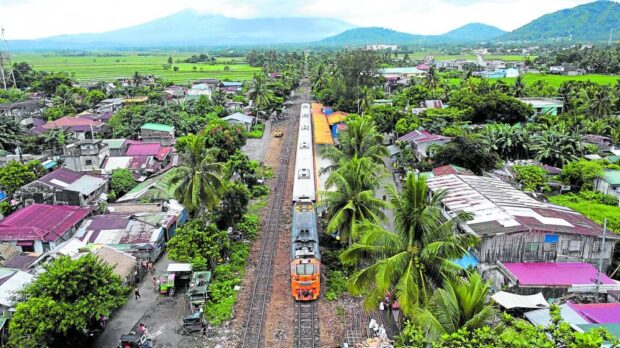PNR reopens Naga-Legazpi rail line after six years

A PNR train waits for passengers at a station in Ligao City in Albay province in this photo taken in October. By Dec. 27, the Naga in Camarines Sur to Legazpi in Albay route, which stopped operations in 2017, will reopen. —REYNALDO II A. SINSON/
CONTRIBUTOR
MANILA, Philippines — The train operations from Naga City in Camarines Sur to Legazpi City in Albay reopened to the public on Wednesday after a six-year suspension, the Philippine National Railways (PNR) said.
According to PNR, its trains once again resumed services on the routes after a temporary suspension in April 2017 due to a lack of enough train coaches and locomotives.
“Ngayong umaga, December 27, matapos ang higit na anim na taon, muling tinahak ng mga PNR trains ang 101-kilometrong rutang Naga-Legazpi-Naga sa Bicol Region,” PNR said in a press release.
(This morning, December 27, after more than six years, PNR trains once again traveled the 101-kilometer Naga-Legazpi-Naga route in the Bicol Region.)
“Sa pag-arangkada ng mga PNR trains sa nasabing ruta, naisakatuparan ang hiling ng mga Bicolano na unti-unting magbalik ang serbisyo nito sa kanilang mga bayan at rehiyon,” it added.
Article continues after this advertisement(With the launch of PNR trains on the said route, the request of the Bicolanos to gradually return its service to their towns and regions has been fulfilled.)
Article continues after this advertisementThe first trip from Naga to Legazpi departed at 5:38 a.m. while the train coming from Legazpi to Naga left the station at 5:45 a.m., PNR said.
It also noted that the afternoon trip from Naga to Legazpi will be at 5:30 p.m., while the trip from Legazpi to Naga will be at 5:47 p.m.
The travel time between the two cities takes three hours, PNR added.
READ: Bicol Express: Naga-Legazpi rail line reopens
Meanwhile, other stations in between Naga and Legazpi where passengers may also alight include Pili, Iriga, Polangui, Ligao, Travesia, and Daraga.
READ: PNR weighs other funding options for P142-B South Long Haul project
Moreover, PNR said that the flag stops are in Baao, Lourdes, Bato, Matacon, Oas, Bagtang, Washington Drive, and Capantawan.
It also reminded the public that the fare ranges from P15 to P155 and a 20 percent discount is offered to students, senior citizens, and persons with disabilities.